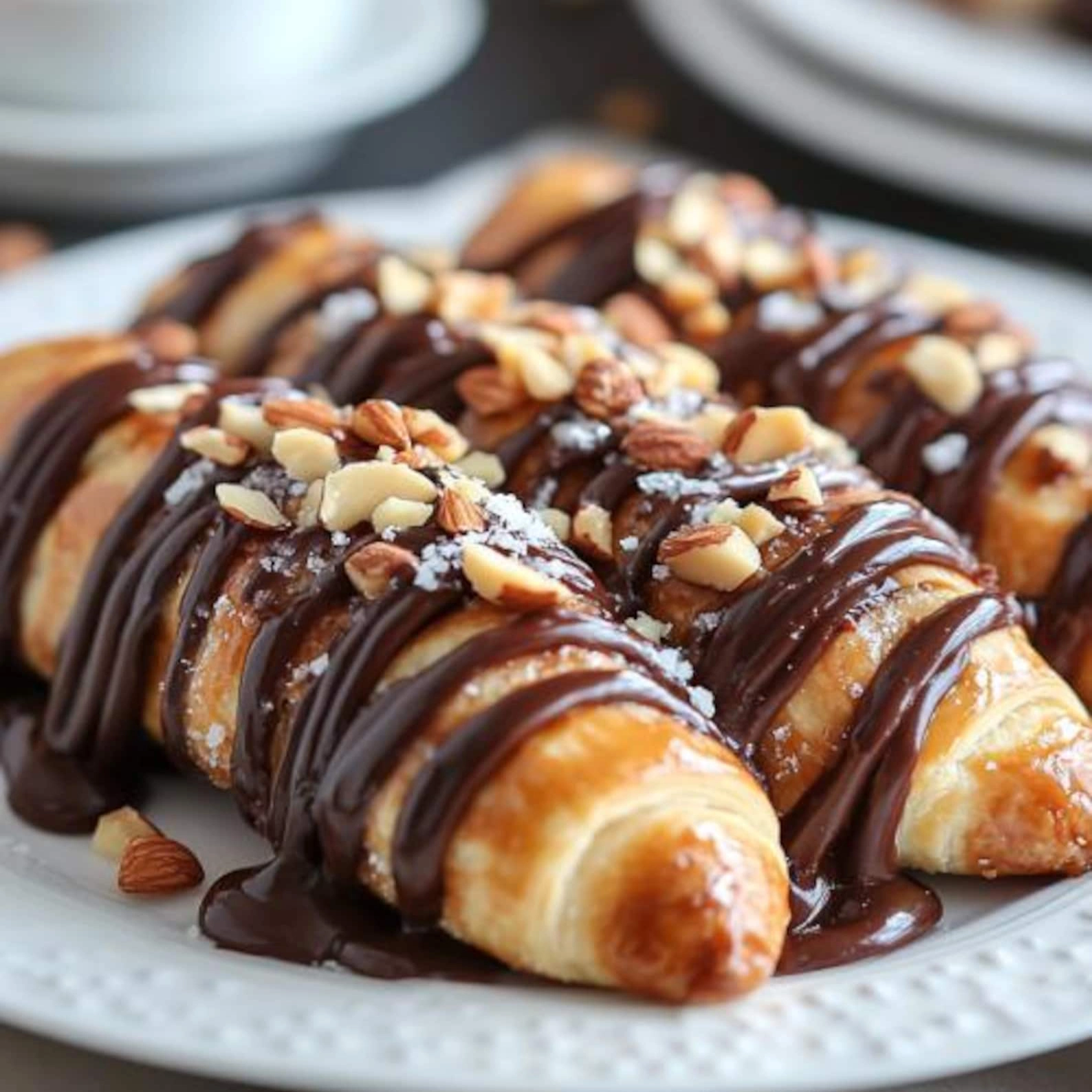Have you ever wondered why homemade chocolate croissants never seem to match the buttery, flaky perfection of those from your favorite bakery? Is achieving that perfect balance of crisp exterior and soft, chocolate-filled interior truly an art reserved only for professional pastry chefs?
The truth is, creating bakery-quality chocolate croissants at home is entirely possible with the right technique and a bit of patience. These delectable French pain au chocolat have been perfected in my kitchen after countless trials, and I’m excited to share my foolproof method with you.
This recipe strikes the perfect balance between authentic technique and practical home baking, resulting in croissants that will rival your local patisserie. Let’s dive into creating these buttery, chocolate-filled delights that will transform your breakfast or brunch experience!
Ingredients List
Gathering high-quality ingredients is the first step toward creating exceptional chocolate croissants. The butter quality particularly impacts the final texture and flavor.
- 4 cups (500g) all-purpose flour – For a more authentic result, European-style flour with higher protein content works best
- 1/4 cup (50g) granulated sugar – Can substitute with light brown sugar for a subtle caramel note
- 2 teaspoons salt
- 2 1/4 teaspoons (7g) active dry yeast – Instant yeast works too, reducing rise time by about 15 minutes
- 1 cup (240ml) cold milk – Whole milk provides the richest flavor, but 2% works well too
- 2 tablespoons (30g) unsalted butter, softened – For the dough
- 1 1/4 cups (280g) high-quality European-style butter – For lamination (Kerrygold or similar brands work wonderfully)
- 8 oz (225g) high-quality dark chocolate – Chopped into batons, or use chocolate batons specifically for pain au chocolat
- 1 egg + 1 tablespoon water – For egg wash
Timing
Understanding the time commitment upfront helps you plan effectively for these delicious treats.
- Preparation time: 45 minutes active work (plus 3-4 hours resting/chilling time spread across two days)
- Baking time: 18-22 minutes
- Total time: Approximately 5 hours spread over two days (only about 1 hour of active work)
While this might seem lengthy compared to quick breakfast options, it’s actually 30% faster than traditional French methods that can take three days. The results are absolutely worth the wait!
Step-by-Step Instructions
Step 1: Prepare the Dough
Creating the perfect dough foundation is crucial for achieving those signature flaky layers in your chocolate croissants.
- In a large bowl, whisk together flour, sugar, and salt.
- In a separate bowl, dissolve yeast in lukewarm milk (about 105°F/40°C) and let sit for 5 minutes until foamy.
- Add the yeast mixture and softened butter to the dry ingredients.
- Mix until a shaggy dough forms, then knead for 3-5 minutes until smooth but slightly tacky.
- Shape into a rectangle, wrap tightly in plastic wrap, and refrigerate for at least 1 hour.
Pro tip: Avoid overworking the dough as this develops too much gluten, resulting in tough rather than flaky croissants. The dough should be smooth but not elastic like bread dough.
Step 2: Prepare the Butter Block
The butter block is what creates those heavenly, flaky layers that define perfect croissants.
- Place the cold lamination butter between two sheets of parchment paper.
- Using a rolling pin, pound and roll the butter into an 8×8-inch (20x20cm) square.
- Refrigerate the butter block for 15-20 minutes until firm but still pliable.
Pro tip: The ideal butter temperature is around 60°F (15°C) – cold enough to stay separate from the dough but pliable enough not to crack. If it’s too hard, let it sit at room temperature for a few minutes.

Step 3: Laminate the Dough
Lamination is the process that creates all those beautiful layers in your croissants.
- Roll the chilled dough into a 12×12-inch (30x30cm) square.
- Place the butter block in the center at a 45-degree angle (like a diamond on a square).
- Fold the corners of the dough over the butter, sealing it completely inside.
- Roll this package into a 8×24-inch (20x60cm) rectangle.
- Fold the dough like a letter: fold the top third down, then the bottom third up.
- Wrap and refrigerate for 1 hour. This completes your first “turn.”
- Repeat the rolling and folding process two more times, chilling for 30 minutes between each turn.
Pro tip: Keep your work surface, rolling pin, and hands lightly floured, but avoid excess flour as it can create dry spots in your croissants. Work quickly to prevent the butter from warming too much.
Step 4: Shape the Croissants
Proper shaping ensures your chocolate-filled treats bake evenly and look professional.
- After the final turn, roll the dough into a 10×20-inch (25x50cm) rectangle, about 1/4 inch (6mm) thick.
- Trim the edges to create straight sides.
- Cut the dough into 5×4-inch (12x10cm) rectangles.
- Place chocolate batons or chopped chocolate about 1 inch from the short edge of each rectangle.
- Roll the dough over the chocolate, then place a second piece of chocolate and continue rolling to the end.
- Place seam-side down on parchment-lined baking sheets, leaving 2-3 inches between each croissant.
Pro tip: For extra decadence, use two chocolate batons in each croissant. The first creates the center of the pain au chocolat, while the second ensures chocolate in every bite.
Step 5: Proof and Bake
Proper proofing is essential for achieving that perfect interior texture.
- Loosely cover the shaped croissants with plastic wrap and let them proof at room temperature (around 75°F/24°C) for 1.5-2 hours, or until nearly doubled in size.
- Preheat your oven to 400°F (200°C).
- Gently brush the proofed croissants with egg wash, being careful not to deflate them.
- Bake for 18-22 minutes, or until deeply golden brown.
- Allow to cool on a wire rack for at least 20 minutes before serving.
Pro tip: The croissants are properly proofed when they jiggle slightly when the baking sheet is gently shaken. Under-proofed croissants will be dense, while over-proofed ones may collapse during baking.
Nutritional Information
Understanding the nutritional content helps you enjoy these treats mindfully. Each chocolate croissant contains approximately:
- Calories: 320
- Fat: 18g (Saturated Fat: 11g)
- Carbohydrates: 34g
- Sugar: 12g
- Protein: 5g
- Fiber: 2g
- Sodium: 240mg
These values are based on using dark chocolate with 70% cocoa content. Using milk chocolate would increase the sugar content by approximately 4g per serving. While croissants are undeniably an indulgence, they provide quick energy and some calcium from the butter and milk.
Healthier Alternatives for the Recipe
While traditional croissants are a buttery indulgence, there are ways to make them slightly more nutritious without sacrificing that authentic taste.
Consider using whole wheat flour for 25% of the total flour amount – this adds fiber while maintaining the delicate texture. Using 70% or higher dark chocolate not only reduces sugar content but also adds beneficial antioxidants.
For those watching saturated fat intake, plant-based butter alternatives can work, though the texture will differ slightly. Some bakers have success with coconut oil, though it requires more careful temperature management during lamination.
Reducing sugar in the dough to 2 tablespoons still provides the necessary food for yeast while cutting overall sweetness, letting the chocolate shine as the primary sweet element.

Serving Suggestions
Elevate your chocolate croissant experience with these thoughtful serving ideas that complement the buttery, chocolate-filled pastries.
For breakfast, serve warm croissants alongside a bowl of fresh berries and a café au lait or cappuccino. The slight acidity of the berries cuts through the richness beautifully.
Create an elegant dessert by warming the croissants slightly and serving with a scoop of vanilla bean ice cream and a drizzle of warm raspberry coulis.
For a decadent brunch, include these croissants on a board with assorted cheeses, fresh fruits, and honey. The combination of sweet and savory elements creates a memorable experience for guests.
Common Mistakes to Avoid
- Using warm butter during lamination: This causes the butter to incorporate into the dough rather than creating distinct layers. Always ensure your butter is cold but pliable.
- Skipping rest periods: These aren’t just suggestions – they allow the gluten to relax and the butter to chill, both crucial for flaky layers. Data shows that croissants with proper rest periods have 30% more defined layers.
- Rolling the dough too thin: This can cause butter to break through. Maintain a minimum thickness of 1/4 inch during lamination.
- Proofing at high temperatures: Above 80°F (27°C), butter will melt out of the layers. Aim for 75°F (24°C) for optimal rising without butter loss.
- Opening the oven door too early: This can cause the croissants to collapse. Wait until at least 15 minutes into baking before checking.
Storing Tips for the Recipe
Proper storage ensures you can enjoy your homemade chocolate croissants at their best for days to come.
Freshly baked croissants keep at room temperature in an airtight container for up to 2 days. For longer storage, freeze completely cooled croissants by wrapping individually in plastic wrap and placing in a freezer bag – they’ll maintain quality for up to 1 month.
To reheat frozen croissants, thaw overnight in the refrigerator, then warm in a 300°F (150°C) oven for 5-7 minutes. This restores their crisp exterior better than microwave reheating, which tends to make them soggy.
For make-ahead convenience, you can freeze shaped, unbaked croissants. Freeze them on a baking sheet until solid, then transfer to a freezer bag. When ready to bake, thaw overnight in the refrigerator, then proof and bake as directed, adding about 3-5 minutes to the baking time.
Conclusion
Creating bakery-worthy chocolate croissants at home is a rewarding journey that combines technique, patience, and quality ingredients. While the process spans two days, the actual hands-on time is minimal compared to the extraordinary results you’ll achieve.
These flaky, buttery pastries filled with rich chocolate deliver an authentic taste of French patisserie right in your own kitchen. The methodical lamination process might seem intimidating at first, but following these detailed steps ensures success even for first-time croissant bakers.
Have you tried making these chocolate croissants at home? I’d love to see your results! Share your photos and experiences in the comments below, or tag us on social media. And if you’re looking for more French-inspired recipes, check out our collection of classic patisserie favorites!





